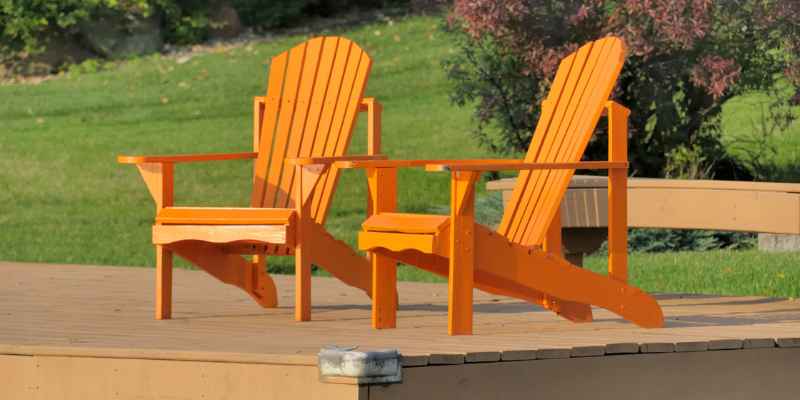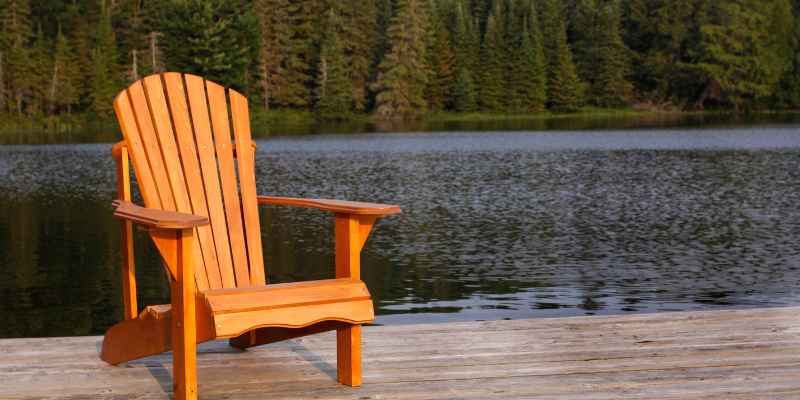For Adirondack chairs, cedar, teak, and pine are popular wood choices due to their durability and weather resistance. These woods provide a balance of strength and aesthetics, making them ideal for outdoor furniture.
Cedar is known for its natural resistance to decay and insects, while teak offers superior durability and a timeless look. Pine is a cost-effective option that can be treated to enhance its longevity. Each wood type brings unique qualities to Adirondack chairs, allowing you to choose based on your preferences and budget.
Introduction To Adirondack Chairs
Discover the ideal wood for Adirondack chairs, ensuring durability and beauty for your outdoor space. Explore the best options, including cedar, teak, and mahogany, to create a comfortable and timeless seating experience.
Adirondack chairs are a popular outdoor furniture choice, known for their comfort and classic design. These chairs are perfect for relaxing on a warm summer day, enjoying a good book or conversation with friends. However, not all Adirondack chairs are created equal. The type of wood used to make the chair can greatly impact its durability and longevity. In this post, we will explore the origins and popularity of Adirondack chairs, as well as the importance of choosing the right wood.
Origins And Popularity
Adirondack chairs were first created in the early 1900s by a man named Thomas Lee, who was seeking a comfortable outdoor chair for his family’s summer home in the Adirondack Mountains of upstate New York. The chair’s design was inspired by the rugged terrain of the Adirondacks, with wide armrests and a slanted backrest that offered both comfort and support.
Today, Adirondack chairs are beloved by homeowners and outdoor enthusiasts around the world. Their timeless design and comfortable seating make them a popular choice for any outdoor space, from patios to parks to the beach.
Importance Of Choosing The Right Wood
When it comes to Adirondack chairs, choosing the right wood is crucial. The type of wood used can impact everything from the chair’s durability to its appearance. Some popular wood choices for Adirondack chairs include:
- Cedar: A lightweight wood that is naturally resistant to rot and decay.
- Pine: A softwood that is affordable and easy to work with, but may require more maintenance over time.
- Teak: A hardwood that is highly durable and resistant to weathering, but can be more expensive.
- Recycled plastic: A low-maintenance and eco-friendly option that is also highly durable.
Choosing the right wood for your Adirondack chair will ensure that it lasts for years to come, even with regular use and exposure to the elements.
In conclusion, Adirondack chairs are a classic and comfortable outdoor furniture choice, perfect for any outdoor space. When selecting an Adirondack chair, it’s important to consider the type of wood used in its construction to ensure its durability and longevity.
Types Of Wood For Adirondack Chairs

When it comes to choosing wood for Adirondack chairs, it’s essential to consider the type of wood that will best suit your needs. The right wood can enhance the beauty and durability of your chairs, ensuring they withstand the elements and provide comfort for years to come.
Softwoods Vs. Hardwoods
Softwoods and hardwoods are two main categories of wood used for Adirondack chairs. Softwoods, such as cedar and pine, are lightweight and easy to work with, making them popular choices for outdoor furniture. On the other hand, hardwoods like teak and mahogany offer superior strength and resistance to decay, ideal for long-lasting outdoor pieces.
Common Choices: Cedar, Pine, Teak, And Mahogany
When selecting wood for Adirondack chairs, common choices include cedar, pine, teak, and mahogany. Each type of wood has its unique characteristics that make it suitable for different preferences and environments.
Cedar: Natural Beauty And Resistance
Cedar is a popular choice for Adirondack chairs due to its natural beauty and exceptional resistance to weathering. Its stunning reddish-brown hue and smooth grain make it an attractive option for outdoor furniture. Additionally, cedar wood naturally contains oils that act as preservatives, making it highly resistant to decay, insects, and rot.
Pros And Cons
When considering cedar for Adirondack chairs, it’s essential to weigh the advantages and disadvantages.
Maintenance Tips
To ensure the longevity of cedar Adirondack chairs, proper maintenance is crucial. Here are some essential maintenance tips:
- Regularly clean the chairs with a mild soap and water solution.
- Apply a protective finish or sealant to enhance durability and maintain the wood’s natural beauty.
- Inspect for any signs of wear or damage and address them promptly.
Pine: Affordable And Customizable
Pine is an affordable and customizable wood for Adirondack chairs. It offers a natural, rustic look and can be easily stained or painted to match your outdoor decor. With its durability and cost-effectiveness, pine is a popular choice for creating stylish and comfortable outdoor seating.
Pros And Cons
Pine is a popular choice for Adirondack chairs due to its affordability and customizability. Let’s explore the pros and cons of using pine wood for these iconic outdoor chairs.
Pros:
- Affordable: Pine is one of the most budget-friendly wood options for Adirondack chairs, making it a great choice for those on a tight budget.
- Customizable: Pine wood can be easily painted or stained to match your desired color scheme or personal style, giving you the freedom to create a chair that perfectly complements your outdoor space.
- Lightweight: Pine is relatively lightweight compared to other woods, making it easier to move and rearrange your Adirondack chairs as needed.
- Natural Beauty: Pine wood has a natural grain pattern that adds warmth and character to the chairs, enhancing their overall aesthetic appeal.
Cons:
- Less Durable: Pine is a softwood, which means it is more prone to scratches, dents, and weathering compared to hardwoods like teak or cedar. Regular maintenance is necessary to prolong the lifespan of pine Adirondack chairs.
- Requires Sealing: Pine wood needs to be properly sealed and protected to prevent rot, decay, and insect damage. Applying a weather-resistant finish is essential to ensure the longevity of the chairs.
- Prone to Warping: Pine can be susceptible to warping or twisting when exposed to extreme temperature changes or high humidity. Proper care and maintenance, including storing the chairs in a covered area during harsh weather conditions, can help minimize this issue.
Maintenance Tips
To keep your pine Adirondack chairs in optimal condition and extend their lifespan, follow these maintenance tips:
- Regular Cleaning: Wipe down the chairs with a damp cloth or gentle soap and water solution to remove dirt, dust, and debris.
- Sealant Application: Apply a high-quality sealant or weather-resistant finish to protect the wood from moisture, UV rays, and insect damage. Reapply the sealant as needed, typically every 1-2 years.
- Keep Covered: When not in use, store the chairs in a covered area, such as a shed or garage, to shield them from harsh weather conditions.
- Inspect Regularly: Check the chairs for any signs of damage, such as cracks or splinters, and address them promptly to prevent further deterioration.
Teak: Premium Choice For Durability
Pros And Cons
Teak wood is highly durable and weather-resistant, making it ideal for outdoor furniture.
- Pros:
- Resistant to rot, decay, and pests
- Can withstand harsh weather conditions
- Natural oils provide inherent protection
- Requires minimal maintenance
- Beautiful, timeless aesthetic
- Cons:
- Higher initial cost compared to other woods
- Color can fade over time if not maintained
- Requires occasional cleaning to preserve appearance
Maintenance Tips
Regularly clean teak chairs with a mild detergent and water to prevent discoloration.
- Apply teak oil or sealer annually to maintain its natural honey-brown color.
- Avoid using harsh chemicals or pressure washers, as they can damage the wood.
- Consider sanding the surface to remove any weathered areas and restore its smooth finish.
Mahogany: Rich Color And Durability
Mahogany wood is known for its rich color and exceptional durability. It adds a touch of elegance to Adirondack chairs, making them stand out in any outdoor setting.
Pros And Cons
Pros:
- Rich color adds aesthetic appeal
- Durable and long-lasting
- Resistant to rot and decay
Cons:
- Expensive compared to other woods
- Requires regular maintenance to preserve color
Maintenance Tips
To maintain the beauty of mahogany Adirondack chairs:
- Regularly clean with mild soap and water
- Apply a protective sealant annually
- Avoid prolonged exposure to direct sunlight
Comparing Costs And Lifespan
When considering the best wood for Adirondack chairs, it’s important to compare the costs and lifespan of different wood options. Factors such as durability, weather resistance, and maintenance requirements should be taken into account to make an informed decision for a long-lasting and cost-effective choice.
Initial Investment Vs. Long-term Value
In the debate of initial cost versus durability, it’s crucial to consider the long-term value of the wood used for Adirondack chairs. Some options may be cheaper upfront but require more frequent replacements, while others might have a higher initial cost but last for decades.
Lifespan Expectations By Wood Type
When selecting the wood for Adirondack chairs, it’s essential to understand the lifespan expectations associated with each type. Different woods offer varying levels of durability and resistance to weathering and decay.
When comparing costs and lifespan of different wood types for Adirondack chairs, consider the initial investment versus long-term value and the lifespan expectations by wood type. Choose a wood that balances affordability with durability to ensure your chairs stand the test of time.
Weathering And Maintenance
To ensure the longevity of Adirondack chairs, the type of wood used is crucial. Cedar and teak wood are popular choices due to their natural resistance to weathering. Regular maintenance, such as cleaning and sealing, can also help protect the chairs from the elements and extend their lifespan.
Protection Against Elements
Wood Adirondack chairs are durable but require protection from weather elements.
Regular Maintenance Tasks
Regularly clean, sand, and apply sealant to maintain the wood chairs.
Eco-friendly And Sustainable Options

Choosing the right wood for Adirondack chairs involves considering eco-friendly and sustainable options. By selecting materials that are sourced responsibly, you can enjoy both style and peace of mind.
Reclaimed Wood Choices
Reclaimed wood for Adirondack chairs offers a unique character and history. It reduces waste by repurposing old materials for a new purpose.
Certified Sustainable Woods
Certified sustainable woods such as teak and cedar are ideal for eco-conscious buyers. These options come from well-managed forests and are harvested responsibly.
Conclusion: Making The Right Choice
Choosing the right wood for your Adirondack chairs is important for both aesthetics and durability. Factors such as climate, maintenance, and cost should be considered when making your choice. Ultimately, the right wood will provide comfort and longevity for many relaxing moments outdoors.
Balancing Aesthetics, Durability, And Cost
When choosing the right wood for Adirondack chairs, it’s important to balance aesthetics, durability, and cost. Aesthetics are a key consideration as different wood types offer unique natural grains and colors. Durability is vital for outdoor furniture, so selecting a wood that can withstand the elements is crucial. Cost is also a factor, as some wood species may be more budget-friendly than others.
Personal Preference And Lifestyle Considerations
Personal preference and lifestyle play a significant role in the wood selection process. Your preferred chair style and the overall look you want to achieve will influence your decision. Additionally, your lifestyle and how you plan to use the chairs, whether for frequent outdoor gatherings or occasional relaxation, should guide your choice of wood.
Frequently Asked Questions
What Type Of Wood Is Best For Adirondack Chairs?
Cedar, teak, cypress, and pressure-treated pine are some of the popular choices for Adirondack chairs. Cedar is the most preferred wood for its natural resistance to decay, insects, and moisture. Teak is another durable option but is more expensive. Cypress has a distinct look and is resistant to rot and insects.
Pressure-treated pine is affordable and treated to resist rot and insects.
Can I Use Treated Lumber For Adirondack Chairs?
Yes, you can use pressure-treated lumber for Adirondack chairs. The treatment protects the wood from rot and insects, making it last longer. However, you should be aware that treated lumber may contain chemicals that can be harmful to humans and the environment.
Make sure to wear protective gear when working with it and dispose of it properly.
How Do I Maintain Adirondack Chairs Made Of Wood?
Regular maintenance is necessary to keep Adirondack chairs looking good and lasting longer. Clean the chairs with a mild soap and water solution and let them dry thoroughly. Apply a wood sealer or preservative to protect the wood from moisture and UV rays.
Sanding and refinishing may also be necessary to restore the chairs’ appearance.
What Is The Weight Capacity Of Adirondack Chairs?
The weight capacity of Adirondack chairs depends on the type of wood and design. Cedar and teak Adirondack chairs can typically support up to 300 pounds, while pine chairs may have a lower weight capacity. It is important to check the weight capacity of the chairs you are considering and ensure they can support the weight of the intended user.
Conclusion
To conclude, choosing the right wood for your Adirondack chairs is crucial for their longevity and aesthetics. By considering factors such as durability, weather resistance, and maintenance requirements, you can make an informed decision. Whether you opt for teak, cedar, or another wood type, ensure it aligns with your preferences and budget.
Remember, investing in high-quality wood will enhance the overall comfort and beauty of your outdoor space for years to come.


